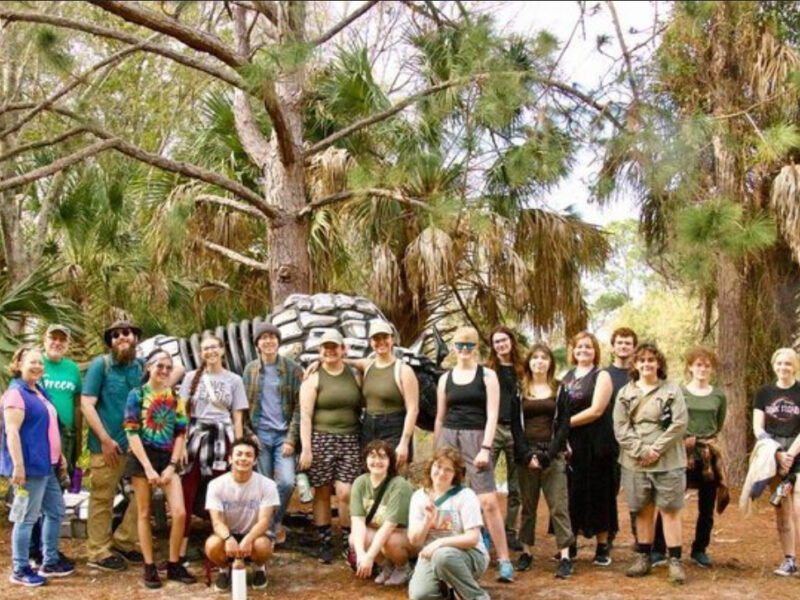Pictured Above: Erida Ajazi (left), who teaches at USFSP and SPC, is teaching two introductory Spanish classes at USF St. Petersburg this semester. Nathalie Dragwa, a first time foreign-language student, shares her struggles with learning American Sign Language online.
Courtesy of Erida Ajazi and Nathalie Dragwa
By Catherine Hicks
When Nathalie Dragwa, a senior psychology major, enrolled in her first foreign language class, American Sign Language, she didn’t expect to struggle with having to learn the language on an online platform.
“I’ve been dealing with trying to teach myself the language,” Dragwa said. “Usually you have a signing partner, can practice in class and have activities together, but since everything is online, I’m stuck teaching myself and practicing in the mirror.”
Other students taking foreign language classes echo the sentiment of struggling with online learning because COVID-19 has forced classes online.
“It is harder because I can’t really ask all the questions I would like without my professor,” said Jennifer Steiner, a senior microbiology major taking Arabic. “I also don’t have easy access to practice with other students.
“It’s annoying to have to use Teams, I hate having to use the camera and it can be a bit awkward.”
Steiner previously took Spanish in an in-person forum and says she prefers that over online learning.
Dragwa shares the feeling.
“Connect with your students,” Dragwa said. “They are struggling. Provide as much help as you can. Be easy.
“Some professors are not understanding that we are at home trying to reach ourselves something that should be taught inside the classroom with partners and hands on help… My professor posts videos of him signing with no sound on, but it’s really hard trying to understand what he’s signing and making sure I’m understanding the right way to sign as well.
“It’s a lot to handle because you really only have yourself throughout this class – I didn’t sign up to teach myself a language.”
Dragwa worries that students aren’t given enough credit for their efforts and that professors are failing to grasp the difficulty of learning a language online.
“We are trying our hardest, but our professors need to give us a change to grasp it,” Dragwa said. “The online world is completely different compared to a normal class. Professors need to connect more with online classes and switch up their lesson plans to connect online.”
Despite students feeling alone and unheard, some foreign language professors are not only aware of the struggles students are facing from online classes, but are also working to assist students.
“When we switched to online in March, I had several students that struggled to adapt to remote learning and were not very happy with the online teaching,” said Erida Ajazi, a professor at USF and St. Petersburg College, is teaching two sessions of beginning Spanish online this semester at USF.
She recognized many hindrances to her students’ online learning, such as the loss of interpersonal relationships, digital access and connectivity and work or family stressors related to COVID-19.
“In an online class, as professors we grapple with how to maintain the same level of engagement, concentration and discourse that students have in a face-to-face classroom,” Ajazi said.
Ajazi shared a belief that the “artistic tradition” of teaching which is the relationships, creativity and inspiration found within a class is the most important difference between a traditional classroom and online learning because it is difficult to recreate in online teaching.
“I noticed that their attention and motivation in the online class dropped significantly and they didn’t do as well on their exams,” Ajazi said.
She shared multiple instances where a student encountered an obstacle in completing their work in which she “had to be very understanding and flexible to help (them) meet the course and learning objectives.”
Despite the problems presented in learning a second language through an online platform, Ajazi expressed that an in-person class would likely be worse for students, due to the necessity of wearing a mask during in-person classes.
“Wearing a mask will be especially challenging during pronunciation of the new words, as students need to see the placement and the position of the tongue and lips,” Ajazi said. “The mask will have a huge impact on students with a beginner level of Spanish and would inhibit not only the ability to practice pronunciation, but also the ability to understand the professor while speaking in a foreign language.”
Citing a study completed by the University of Barcelona in June, Ajazi also contended that even upper level students might struggle with wearing a mask, as, according to the study, “in a conversation between adults, speakers tend to look into each other’s eyes when speaking their mother tongue, but when trying to understand a person who speaks a second language, you look more at their mouth,” Ajazi said.
“The study concluded that all students, no matter how high their level of a foreign language, focused their visual attention on the mouth of the interlocutor,” she continued.
Despite the obstacles presented by online teaching, Ajazi was “happily surprised” to see that some students excelled in online classes.
“Though there were a few students that struggled with online teaching, I also had a couple of students who did much better when we shifted online,” Ajazi said. “They had found the right environment that helped them rise to their potential. I think that online classes can benefit introverted students as they can be free from the social anxiety.”



